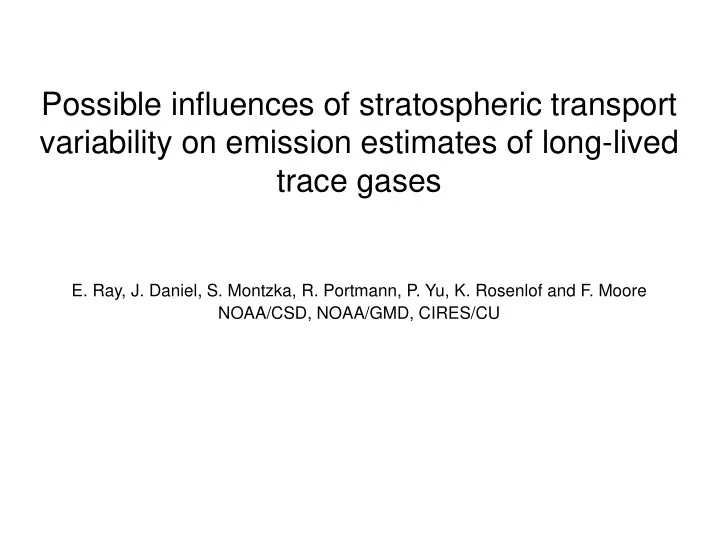

Possible influences of stratospheric transport variability on emission estimates of long-lived trace gases E. Ray, J. Daniel, S. Montzka, R. Portmann, P. Yu, K. Rosenlof and F. Moore NOAA/CSD, NOAA/GMD, CIRES/CU
Measured Interannual Variability From NOAA/GMD ECD flask measurements
Measured Interannual Variability From NOAA/GMD combined measurements
Measured Interannual Variability Stratospheric circulation anomalies From satellite measurements (swoosh, S. Davis)
Measured Interannual Variability From NOAA/GMD flask and in situ measurements
Measured Interannual Variability Dashed lines are linear fits to the NH-SH time series from 2002-12.
Measured Interannual Variability Stratospheric lifetimes: ~30 years ~50 years ~50 years ~100 years ~100 years ~115 years
Stratospheric Circulation Photolytic loss is determined by transport through the loss regions in the stratosphere. Photolytic loss How much can regions stratospheric transport variability (both globally and NH vs. SH changes) affect surface trace gas variability? We use an idealized model to try to quantify the impacts of the stratospheric variability. equator
Idealized Modeling F11-like molecule Imposed growth rate and stratospheric lifetime
Idealized Modeling F11-like molecule Derived NH-SH gradient and emissions
Idealized Modeling For F11-like molecule, imposed 20% stratospheric circulation speed up causes: ~35% decrease in global growth rate Negligible decrease in N-S gradient since the stratospheric circulation is close to symmetric No emission change
Idealized Modeling For F11-like molecule, imposed ~20% stratospheric circulation NH-SH change causes a large increase in N-S gradient with time lag
Can Observed Tracer Variability be Caused by the Stratosphere? NH-SH Anomalies Global Growth Rate Changes
Idealized Modeling of Recent Stratospheric Circulation Anomalies NH-SH Gradient The recent NH-SH gradient changes scale roughly by inverse lifetime and could be well explained by a shift in stratospheric NH vs. SH transport.
Idealized Modeling of Recent Stratospheric Circulation Anomalies More rapid slow down 20% speed up (more Gradual slow back loss) down (less loss)
Idealized Modeling of Recent Stratospheric Circulation Anomalies For F11-like molecule, imposed stratospheric circulation changes causes: global growth rate decrease and then increase Negligible changes in N-S gradient No emission anomalies
Idealized Modeling of Recent Stratospheric Circulation Anomalies For F11-like molecule, imposed global growth rate decrease and then increase due to unaccounted for stratospheric changes causes: Large emission decrease then increase Large N-S gradient decrease then increase
Idealized Modeling of Recent Stratospheric Circulation Anomalies Emissions Impact
Idealized Modeling of Recent Stratospheric Circulation Anomalies Emissions Impact This emission structure could be explained by stratospheric variability
Conclusions - The stratospheric circulation matters, even down here at the surface! - Imperfect knowledge of the variability of the stratospheric circulation can have significant impacts on trace gas emission estimates for many years. - Recent stratospheric circulation variability has been unpredictable, we can’t assume the stratosphere will continue doing what it’s been doing. - Precise, accurate, long-term measurements provided by GMD can help us better understand the changing stratospheric influence on the troposphere.
Recommend
More recommend